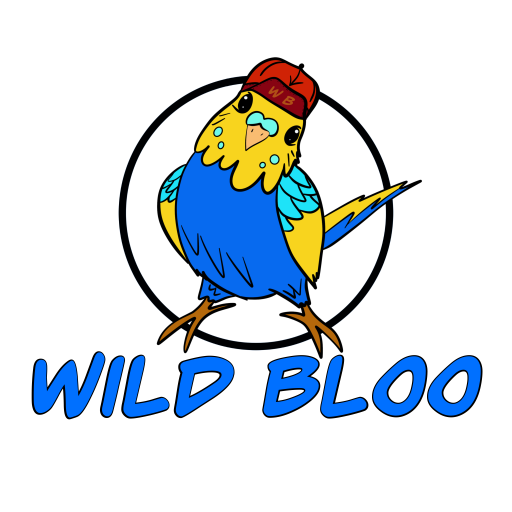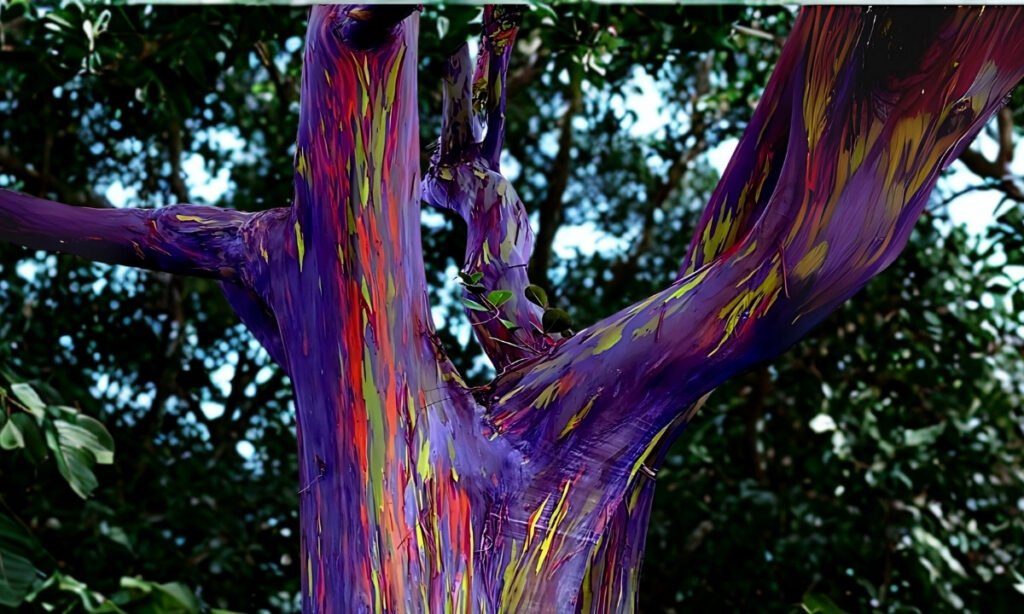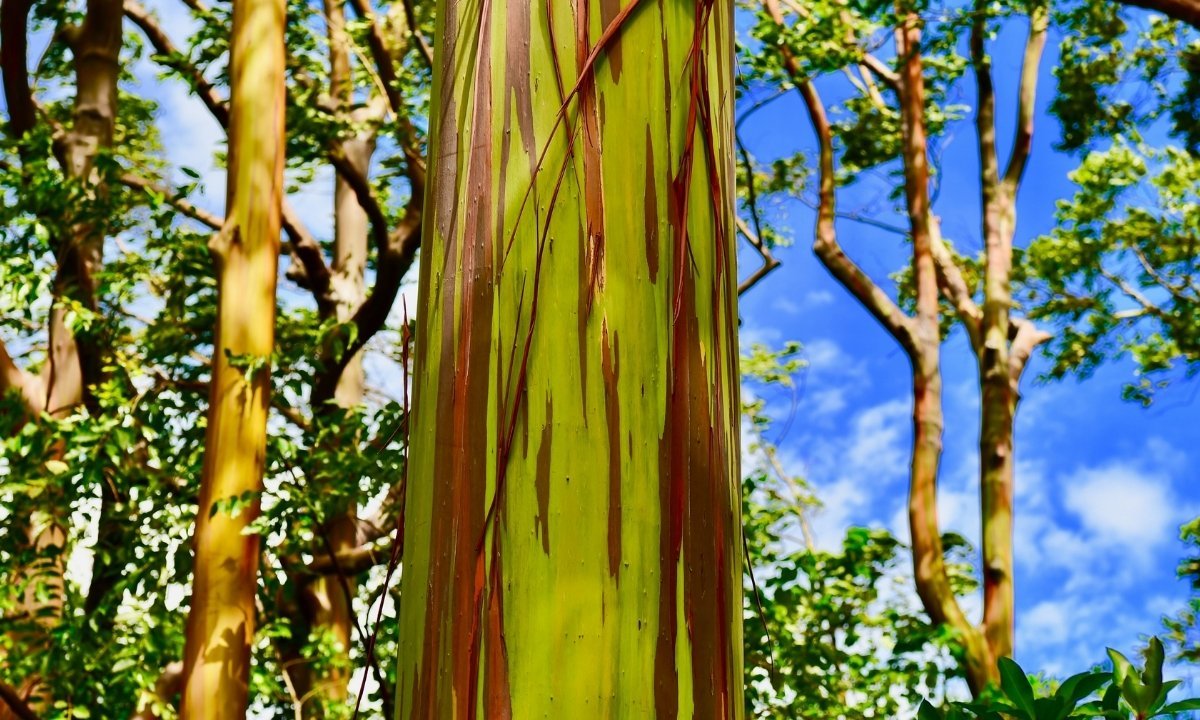The Rainbow Eucalyptus: Nature’s Psychedelic Masterpiece Explained
The Rainbow Eucalyptus is a remarkable tree known for its stunning, multi-colored bark that looks like a living painting. As the tree sheds its bark, it reveals vibrant new layers of green, blue, purple, orange, and maroon, creating a constantly changing, psychedelic effect that makes it one of the most visually striking trees in the world.
What is a Rainbow Eucalyptus Tree?
The Rainbow Eucalyptus is a tall, broadleaf evergreen tree. It is the only eucalyptus species that naturally grows in the Northern Hemisphere. Its fame comes entirely from its unique and incredibly vibrant bark.
Unlike other eucalyptus trees, which are native to Australia, the Rainbow Eucalyptus is found in a completely different part of the world.
The Scientific Name: Eucalyptus deglupta
Botanically, the Rainbow Eucalyptus is known as Eucalyptus deglupta. It belongs to the Myrtle family, Myrtaceae. Knowing its scientific name helps distinguish it from the hundreds of other eucalyptus species.
| Feature | Description |
| Scientific Name | Eucalyptus deglupta |
| Common Names | Rainbow Eucalyptus, Mindanao Gum, Rainbow Gum |
| Native Habitat | Philippines, Indonesia, and Papua New Guinea |
| Tree Type | Broadleaf Evergreen |
| Max Height | Up to 250 feet (76 meters) in its native habitat |
| Key Feature | Multi-colored, peeling bark |
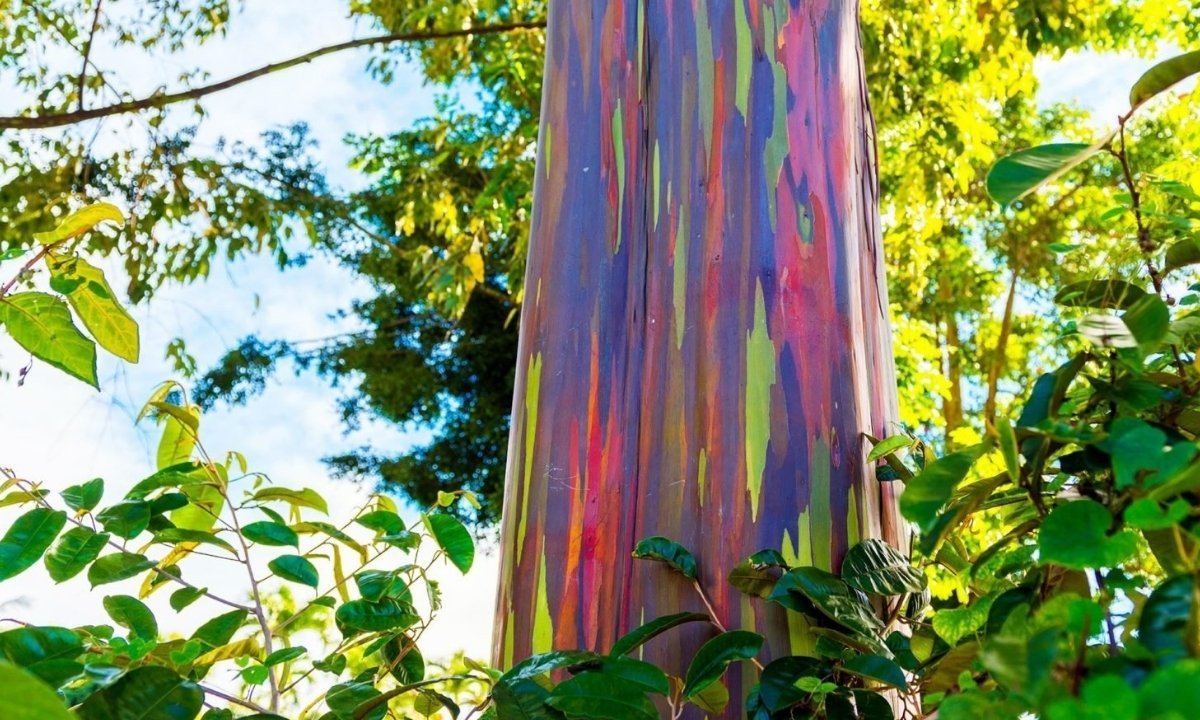
Why is the Rainbow Eucalyptus Tree So Colorful?
The vibrant colors are a direct result of the tree’s life cycle. The phenomenon is not a dye or a disease but a natural and continuous process of shedding its bark.
The Bark Shedding Process Explained
The Rainbow Eucalyptus sheds its bark at different times throughout the year.
Initial Color: When a piece of outer bark flakes off, it first reveals a bright green inner bark.
Color Maturation: This exposed layer then begins to mature. As it ages and is exposed to air and sunlight, it changes color.
The Rainbow Effect: The green bark transforms into shades of blue, purple, and then orange, pink, and red. Because the tree sheds its bark in patches and at different times, you see all these different colors and stages of maturation simultaneously, creating the famous rainbow look.
What Colors Can You Expect?
The palette of the Rainbow Eucalyptus bark includes:
Bright Green (newly exposed bark)
Pastel Blues and Purples
Vibrant Oranges
Deep Reds and Maroons
Where are Rainbow Eucalyptus Trees Found?
The tree’s natural habitat is restricted to specific tropical regions, though it is now cultivated worldwide in suitable climates.
Native Habitat
The Rainbow Eucalyptus is native to the rainforests of:
Mindanao in the Philippines
New Britain in Papua New Guinea
Seram in Indonesia
It thrives in tropical climates with high rainfall and humidity.
Global Cultivation
Due to its beauty, the tree is now grown as an ornamental tree in many other parts of the world, including Costa Rica, Hawaii, and the southern parts of US states like Florida, California, and Texas. However, it rarely reaches the massive heights of its native habitat when cultivated elsewhere.
Key Characteristics of the Rainbow Eucalyptus
Beyond its colorful trunk, the tree shares some characteristics with other eucalypts, but with a few key differences.
Scent: Does it Smell Like Eucalyptus?
Surprisingly, no. While most people associate eucalyptus trees with the strong, medicinal camphor scent used in oils and remedies, the Rainbow Eucalyptus has a very faint scent, if any at all. Its leaves do not produce the same potent aromatic oils as its more famous Australian cousins like Eucalyptus globulus.
Size and Growth Rate
This is a fast-growing tree. In its native environment, it can grow several feet per year and reach towering heights of over 200 feet. When grown ornamentally in less ideal climates, its height is typically more managed, often between 60 and 100 feet.
Cultivating Your Own Rainbow Eucalyptus
Growing a Rainbow Eucalyptus is possible but requires very specific conditions.
Can You Grow a Rainbow Eucalyptus Tree Inside?
Growing a Rainbow Eucalyptus indoors is extremely difficult and generally not recommended. As a fast-growing forest tree that desires full sun and high humidity, it does not adapt well to typical indoor environments.
Growing Outdoors: Climate and Conditions
To grow it successfully outdoors, you need a climate with:
No Frost: The tree is not frost-tolerant.
High Humidity: It thrives in humid conditions.
Plenty of Water: It requires consistently moist soil.
Full Sun: At least 6-8 hours of direct sunlight per day.
It is best suited for USDA hardiness zones 10 and above.
Can You Grow it as a Bonsai?
While theoretically possible, creating a Rainbow Eucalyptus bonsai is a challenge for expert-level bonsai enthusiasts. Its rapid growth rate and large leaf size make it difficult to shape and maintain in a miniature form.
Rainbow Eucalyptus Wood and Its Uses
The tree is cultivated for more than just its looks. In its native range, it is a primary source for pulpwood, which is used to make white paper.
Is Rainbow Eucalyptus Wood Colorful?
No, the stunning colors are exclusive to the bark. The wood of the Rainbow Eucalyptus itself is a light, neutral color, similar to other pulpwood trees.
Can You Buy Rainbow Eucalyptus Wood?
It is very rare to find Rainbow Eucalyptus wood for sale for woodworking, lumber, or furniture. Its primary commercial use is for paper pulp, so the logs are not typically processed for the timber market.
Is the Rainbow Eucalyptus the Rarest Eucalyptus?
No, the Rainbow Eucalyptus is not the rarest eucalyptus tree. While its appearance is incredibly unique, the species itself is widely cultivated for the paper industry and is not considered endangered. There are many other eucalyptus species, such as the critically endangered Eucalyptus recurva (Mongarlowe Mallee), that are far rarer.
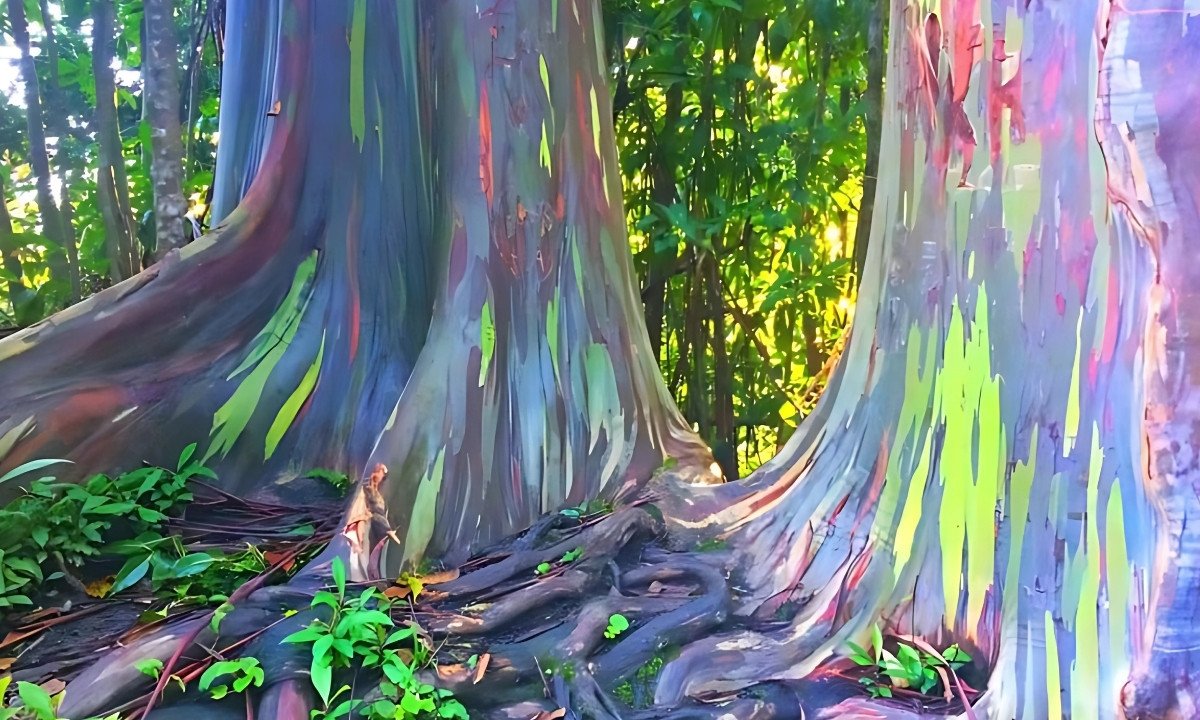
Frequently Asked Questions
1. How long does it take for a rainbow eucalyptus to get its colors?
A young Rainbow Eucalyptus will begin to show its characteristic colors once its trunk reaches a diameter of about 1-3 inches. This process of bark peeling and color changing is continuous throughout the tree’s life, becoming more pronounced as the tree matures and its trunk widens.
2. Is the rainbow eucalyptus tree toxic to dogs or cats?
Yes, like most species in the Eucalyptus genus, the leaves of the Rainbow Eucalyptus are considered toxic to dogs, cats, and horses if ingested. The essential oils can cause symptoms like vomiting, diarrhea, and weakness. It’s best to prevent pets from chewing on the leaves or bark.
3. How much does a rainbow eucalyptus tree cost?
The price of a Rainbow Eucalyptus tree varies significantly based on its size and age. Small saplings or seeds are quite affordable, often ranging from $15 to $50. However, a larger, more established tree that is several feet tall can cost several hundred dollars from a specialty nursery.
4. What kind of birds live in Rainbow Eucalyptus trees?
In their native tropical rainforests, Rainbow Eucalyptus trees provide a vital habitat for a diverse range of bird species. Their towering height offers excellent protection, making them ideal for nesting and roosting. Birds native to the Philippines, Indonesia, and Papua New Guinea, such as various species of parrots, hornbills, kingfishers, and birds-of-paradise, can be found living in these magnificent trees.
